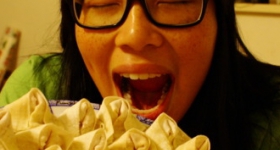Last month I wrote about cognitive distortions and used examples based on Asian American stereotypes to explain what they are. Pretty cliché. This month I'm trying something different, with a perfect example: Eeyore the melancholic donkey from the Winnie the Pooh stories.
Eeyore is commonly used by counselors and psychologists to educate laypeople about cognitive distortions. This sad little donkey definitely sees the world through a distorted prism that reinforces his depression.
If you’ve had a crappy day -- and especially if you have some form of clinical depression -- it becomes really easy to slip into an Eeyore-like attitude. In order to improve his mood, Eeyore could benefit from developing a skillset that will help him to identify when he is falling into distorted thinking and a self-defeating attitude. Learning cognitive restructuring might help him view situations from a more realistic perspective.
Below are quotes from A.A. Milne and the Winnie the Pooh movies, followed by examples about how cognitive restructuring might work for someone like Eeyore. The process involves identifying the distortion he is instinctively using to form a perspective about a situation. Eeyore could examine his negative thoughts to determine whether or not his thinking is faulty. He could then make an honest effort to think about the problem in a more positive and realistic way.
Eeyore, the old grey Donkey, stood by the side of the stream and looked at himself in the water. “Pathetic,” he said. “That's what it is. Pathetic.” He turned and walked slowly down the stream for twenty yards, splashed across it, and walked slowly back on the other side. Then he looked at himself in the water again. “As I thought,” he said. “No better from this side."
Here Eeyore exhibits a number of cognitive distortions as covered in the previous article. He uses Labeling to attach "pathetic" to his self identity.
One method of confronting this cognitive distortion could be to acknowledge a double standard. Eeyore isn't necessarily as harsh on others as he is on himself. Recognizing this "double-standard" might help him treat himself with more compassion. Would he bash one of his friends as "pathetic" the same way he bashes himself?
Another way to defeat this self-harming label could be to survey other perspectives. His friends may have a different attitude towards him. He could also force himself to define the label of “pathetic” more clearly. Is he referring to pathetic behavior or an intangible concept of a "pathetic person"? (Definitions change depending on whom you ask, so how can he objectively label himself as pathetic?)
Food for thought if you’ve ever labeled yourself as “fat” or been labeled by someone else as “ungrateful.”
"Good morning, Pooh Bear," said Eeyore gloomily. "If it is a good morning," he said. "Which I doubt."
Here Eeyore uses emotional reasoning to influence how he views his morning. He feels gloomy, so the idea that the morning might be 'good' is hard for him to grasp. This kind of negativity is a hallmark of negative distortions. In psychology, viewing things in black and white is a kind of all or nothing thinking called “splitting.”
Fighting this cognitive distortion is all about challenging yourself to view life in shades of grey. Eeyore could acknowledge that things are never all wonderful or all terrible. To stop himself from viewing things in extremes (a morning is either "good" or "bad") he could make an effort to rate things on things on a scale of 0 to 100. A morning might not be a perfect 100, but he could still acknowledge both the good and bad that occurred that day.
So, basically: resist the temptation to label your day “a shitty day.”
Christopher Robin: “There now. Did I get your tail back on properly, Eeyore?” Eeyore: “No matter. Most likely lose it again anyway.”
Christopher Robin has reattached Eeyore's lost tail, but Eeyore discounts the positive by insisting that the return of his tail (and his friends' efforts to find it) don't count. (I’m sure his friends are thrilled by his dismissal of their efforts to help him.)
Eeyore prophesizes that nothing good will last. Rather than jumping to the conclusion that he is destined to lose his tail again, Eeyore could examine the evidence instead of assuming his negative thoughts will automatically come true.
Examining the evidence can also help ease anxiety. Mentally kick yourself for prophesizing that you are going to fail that test. There’s no way you can know for sure. If you studied, you might be okay. And even if you didn’t study, you might be able to wing it.
”Nobody tells me," said Eeyore. "Nobody keeps me informed. I make it seventeen days come Friday since anybody spoke to me." "It certainly isn't seventeen days --" "Come Friday," explained Eeyore. "And today's Saturday," said Rabbit. "So that would make it eleven days. And I was here myself a week ago."
Eeyore's mental filter, magnification means that he exaggerates the number of days it has been since anyone has spoken to him (even though he is speaking to someone at that very moment.) He uses all or nothing thinking absolutes like "nobody," "never," and "always" to overgeneralize that this occurs frequently.
In this excerpt, Rabbit challenges Eeyore to examine the evidence in an attempt to get him to acknowledge that people have been talking to him and that Eeyore has exaggerated. (If you’ve ever talked to a “seriously depressed person,” it’s a major a challenge to get them to acknowledge that their perceptions might be distorted. This is why therapists have jobs and play an important role in treating depression and other conditions.)
"You must have left it somewhere," said Winnie the Pooh. "Somebody must have taken it," said Eeyore. "How Like Them," he added, after a long silence.
Eeyore immediately jumps to conclusions that the worst possible situation has occurred. He typecasts and labels other people with very low expectations.
As an alternative, Eeyore could substitute language that is less colorful and emotionally loaded. Instead of saying "Somebody must have taken it" he could say "Maybe someone took it." Instead of blaming himself or others for a problem, he could assess the situation. He could figure out what may have attributed to the problem and focus his energy on solving the problem. But because he’s a pessimist (and likely depressed) he would rather use the loss of his tail as evidence to reinforce his low expectations of other people.
"I shouldn't be surprised if it hailed a good deal tomorrow," Eeyore was saying. "Blizzards and what-not. Being fine today doesn't mean anything."
Here Eeyore again minimizes and discounts the positive -- a sunny today -- by focusing on a negative possibility that might not even happen.
Eeyore could view the situation he is facing as an experiment to test the validity of his negative thought. He would then see that good weather is rarely immediately followed by hail.
---
I hope these examples of cognitive distortions will help Hyphen readers grow more aware of automatic thinking patterns that contribute to stress. It is possible to train yourself to rely less on cognitive distortions. The first step is to become aware that you are using them. Recognizing cognitive distortions is an invaluable skill to develop -- doubly invaluable in your daily life if you experience a lot of stress and anxiety -- both of which can impact your perceptions and emotional reactions.
Unfortunately, telling someone how to think isn’t very effective. Doubly so if you’re telling them their way of thinking is self-flagellation. Sure, Eeyore could practice cognitive restructuring techniques, but that doesn’t necessarily mean he would be motivated to do so. People use cognitive distortions as a maladaptive coping practice because there is a benefit to using them.
It would be important for Eeyore to look at his habits with a cost-benefit analysis perspective. When he assumes that the worst will always happen, how does that benefit him? (He's never too disappointed.) How does this habit hurt him? (He can never enjoy life without worry, because he is always expecting something bad will happen.)
Applying cognitive restructuring to your automatic thought processes is about training yourself to change the way you’ve instinctively approached disappointments and conflicts. In practice, using cognitive restructuring techniques is not easy. It takes a lot of self awareness and effort. It’s like the yoga or martial arts class where you realize that you’ve been breathing incorrectly or holding the wrong posture your entire life.
Ultimately, it’s about calling bullshit on any inner thoughts that are hindering your ability to cope.
* * *
Guest blogger Marissa Lee is an incoming Master's student in Social Welfare at UCLA. She currently serves on the California Mental Health Planning Council. See here for Part I of this post.
Ask a Model Minority Suicide is a Hyphen column, appearing every fourth Thursday. Introductory post for the column here. Resource Guide here. How to Choose Your Therapist here. Go here to see all posts in this series.
Comments, questions, or stories can be posted below -- or sent privately to Sam at aamms[at]hyphenmagazine[dot]com.









Comments